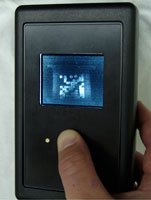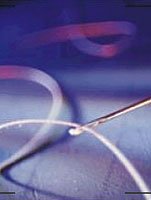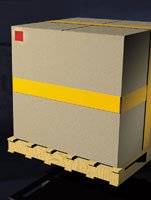New Weapons Target Illegal Textile Trade
While global trade pacts have eliminated many of the quotas and duties associated with the apparel and textile trade, the business of transshipments and counterfeiting remains a problem for big-name brands.
Recent advancements in science and technology may soon put a dent in illegal activities. One of the most promising projects is a textile coding system being developed at the Oak Ridge National Laboratory (ORNL) in Oak Ridge, Tenn., in conjunction with the U.S. Department of Energy.
Scientists there have developed an invisible marking system featuring a fluorescent dye that can be used to identify an exported item’s true point of origin. This could be instrumental in thwarting the influx of transshipments and counterfeits, problems that cost the U.S. government and apparel companies millions of dollars each year.
Transshipments occur when exporters falsify the point of origin on documents as a way to avoid paying taxes or to skirt quota issues. The items are usually routed through an intermediate port before they reach U.S. soil. Some manufacturers in China, for example, use Singapore or Hong Kong to get their goods into the country.
Cracking the code
Counterfeiting remains a problem for big U.S. and international brands. According to the Paris-based Organization for Economic Cooperation and Development, counterfeit goods account for 7 percent of world trade. As a result, governments around the world, such as those of France and Italy, are starting to take drastic measures, imposing fines not only on the sellers but also on the buyers of fake merchandise. In Italy, buying a fake pair of Prada shoes or a Rolex watch carries fines of up to 10,000 euros, or about $12,000. The U.S. government is still focusing on the source of the counterfeits.
In a new era of counterfeiting, buying fake goods is not as innocuous as it may seem. According to Interpol, counterfeit consumer goods have been linked to radical and terrorist groups—including the Irish Republican Army, Al Qaida, Hezbollah and the Revolutionary Armed Forces of Colombia—as a way to raise cash for paramilitary operations. According to the FBI,the 1993 bombing of the World Trade Center in New York was partially funded by the sale of counterfeit T-shirts and sportswear.
Scientists at ORNL think they have finally cracked the code in the fight against illegal trading. The lab said the invisible ink system has been a breakthrough—not so much because it works but because it is the most cost-effective method ORNL has explored over the past few years.
“Our goal is to have a system using a fluorescent dye or other taggant that will cost just tenths of a cent per taggant and can survive the harsh manufacturing process and will not affect the quality of the garment,” said Glenn Allgood of the Department of Energy lab’s Computational Sciences and Engineering Division. “We will also be able to encode specific process information, such as the date and place of manufacture.”
Tough survivor
The research has been made possible through a U.S. Small Business Administration grant. The textile coding system is based on invisible dyes that can be read only by special scanners. The devices identify the source, type, production, condition and composition of textile material. The system is based on light rays that are close to infrared, which can be used as a marker, geometric figure or bar code with millions of letter and number combinations.
The encoding system is less expensive than other information encoding systems, such as those that use DNA or radio frequency identification (RFID). In addition, Allgood and others involved in the collaboration said the ORNL technology has no impact on material properties and provides multiple uses at a low cost, among other advantages.
Recent tests confirm that the tagging process works and can survive the textile manufacturing process, which includes scouring, bleaching, mercerizing, dyeing and finishing, according to ORNL.
Next, Allgood and colleagues at North Carolina State University’s College of Textiles plan to conduct tests using elements of a first-generation system and to work with an industry partner for field tests.
Once the marking system becomes fully operational, U.S. Customs will have the tool available to identify apparel made with U.S. textiles in accordance with trade agreements, added Hardy Poole, a member of the research team. “This will be invaluable to our government in its efforts to eliminate the illegal importation of millions of dollars of non-U.S. textiles that enter our country annually,” he said.
Allgood said the system could be in place within eight months. “Over that time, we will be conducting an extensive material degradation test and lay-down test that will be used to develop engineering design curves,” he said.
Other partners in the effort include the U.S. Department of Agriculture; Clemson University; and manufacturers of yarn, thread, fabric forming, dyeing and finishing, and sewn products.
Industry and academia join hands
While the textile industry is the primary customer for the proposed marker system, Allgood noted that the technology has many other applications, including homeland defense, inventory tracking and control, and military uses.
“We have already been contacted by others as well as industry companies who want to use it in other added-value processes,” Allgood said.
The next phase of the project will involve gaining a better understanding of the stability of tagged materials, specifically whether the marker has an effect on fabric quality. In addition, researchers will investigate the optimum method for depositing the tag onto the material as well as other variables. Eventually, ORNL will likely license the technology to suppliers in addition to the government.
ORNL is managed by UT-Battelle LLC, an alliance comprising the University of Tennessee and Cleveland-based Battelle. The center is a venue for basic and applied research and development aimed at strengthening the country’s leadership in key areas of science. It also is trying to increase the availability of clean, abundant energy, restore and protect the environment, and contribute to national security.
One of the textile identification systems ORNL studied over the past two years was provided by Los Angeles–based Applied DNA Sciences Inc., a provider of DNA-embedded security solutions aimed at protecting corporate and intellectual property from counterfeiting and fraud.
The system may not be used with U.S. Customs, but it has made inroads on other fronts. The company has placed the system with art galleries to mark paintings and with apparel industry suppliers such as Champion Thread Co. in Gastonia, N.C., to develop markers for textiles and apparel.
As a result, Champion Thread has developed the Sentinel line of thread, which is marked with plant DNA that is invisible to the naked eye. The thread can later be identified through DNA testing. Champion Thread officials said Sentinel can be integrated into existing sewing processes without adding manufacturing steps. It is offered in most thread constructions and can be dyed to match various colors.
Robert L. Poovey, president of Champion Thread, said the company will ramp up a campaign to bring the product to major apparel brands over the next few months. “We’re still not there [with education and marketing], but as far as having a viable product, we are there,” he said.
Poovey said he is optimistic about the salability of DNA-embedded threads. “Right now, demand is greater than supply, so it’s nice to be in an oversold position,” he said.
Artistic use
Applied DNA representative Jennifer Gould said the product has found a home in a number of industries. Users at the Brown Gallery in Ojai, Calif., for example, are spraying the product onto paintings.
“It’s based on real plant DNA, not synthetic DNA, so we feel it’s much more accurate,” Gould said. “If you’re dealing with expensive goods, it’s a way to determine if that Gucci or Prada item is real and you’re not being ripped off.”
Gould said that while DNA testing can take about 10 days to identify marked items, the company is developing a scanning system that should significantly reduce that timeline.
Other manufacturers are also exploring the use of RFID tags to fight illegal trade. Since Wal-Mart Stores Inc. and other retailers are instituting mandates to mark shipments with the RFID tags for inventory-control purposes, companies are looking at other uses for the technology. RFID employs small chips containing data that can be read from remote devices. The technology must address a number of challenges, such as cost and privacy issues, before it can be implemented in its current format, industry experts said.
























